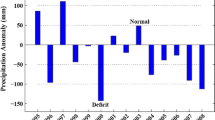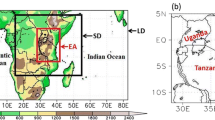Abstract
Cumulus convection is one of the most complex subgrid-scale process parameterized in climate models, which has major influence on the determination of the vertical distribution of energy, water and momentum. Numerous convective parameterizations have been developed and applied in global and regional climate models, with the results being very sensitive to the scheme selection. Thus, it is essential to study the sensitivity of climate models to the convective precipitation schemes. The examined regional climate model used in the study is RegCM4. Its spatial resolution is 25 × 25 km and different simulations were performed with changes in cumulus convection scheme and the corresponding closure assumptions. The selected domain of interest is the Mediterranean region. The simulations were forced by ERA-Interim data and cover the time period 1981–1990. The different simulated data were processed and the differences between the simulations were calculated, compared and mapped in order to examine the modifications that occur in precipitation from changes in convective precipitation scheme.
Access provided by CONRICYT-eBooks. Download conference paper PDF
Similar content being viewed by others
Keywords
These keywords were added by machine and not by the authors. This process is experimental and the keywords may be updated as the learning algorithm improves.
1 Introduction
One of the most complex subgrid-scale processes parameterized in climate models is cumulus convection. This process has major influence on the determination of the vertical distribution of energy, water and momentum. Over the past 30 years, a significant effort has been made in order to understand the interaction between cumulus convection and larger-scale circulations and how to model such interaction in various approaches of cumulus parameterizations (Kuo et al. 1997). Numerous convective parameterizations have been developed and applied in global and regional climate models, with the results being very sensitive to the scheme selection.
For that reason, it was essential to study the sensitivity of climate models, and more specifically of RegCM4, to the convective precipitation schemes.
2 Data and Methodology
The main objective of this study was to examine the modifications that occur in precipitation due to changes in convective precipitation scheme. For this reason, we used precipitation simulated data derived from the regional climate model RegCM4.4.5.1, which is a hydrostatic, compressible, sigma-p vertical coordinate model (Giorgi et al. 1993a, b; Elguindi et al. 2014). Its dynamical core is similar to that of the hydrostatic version of Mesoscale Model version 5 (MM5) (Grell et al. 1994). Its spatial resolution is 25 × 25 km. The area of study is the Mediterranean region (Fig. 1).
Different simulations were performed with changes in cumulus convection scheme and the corresponding closure assumptions for the time period 1981–1990. More specifically, we used MIT-Emanuel cumulus convection scheme (Emanuel 1991; Emanuel and Rothman 1999) over land and ocean, as well as Grell cumulus convection scheme (Grell 1993) with two different closure assumptions; Fritsch–Chappell (GFC) (Fritsch and Chappell 1980a, b) and Arakawa-Schubert (GAS) (Arakawa and Schubert 1974). In these simulations, in order to “run” the latest version of the regional climate model (RegCM4.4.5.1), we utilized ERA-INTERIM data for sea surface temperature (SST) and initial and boundary conditions (ICBC).
The different simulated data were processed on a seasonal basis and the differences between GFC and MIT-Emanuel, as well as GAS and MIT-Emanuel were calculated, mapped and compared. The Student’s t-test was performed in order to find the statistical significance of these differences (Wilks 2006).
3 Results
3.1 Winter
Regarding the changes in precipitation due to alteration from MIT-Emanuel convective precipitation scheme to GAS, an increase of precipitation is simulated in continental areas (Fig. 2a). More specifically, the most statistically significant increase of precipitation is detected in the windward side of the mountainous areas, such as Pindus in Greece, Apennine mountains in Italy, Pyrenees in the Iberian Peninsula, Massif Central mountains in south-central France and Taurus mountains in southeastern Turkey (Fig. 2a). However, in the Alps a significant decrease of precipitation is detected in the southern side of this mountainous range. On the contrary, the maritime areas are characterized by a decrease in precipitation. The most statistically significant decrease is simulated mainly in South Aegean, Adriatic, Balearic and Tyrrhenian Sea (Fig. 2a).
Seasonal differences in precipitation (a and b) between the simulation with Grell cumulus convection scheme and the Arakawa-Schubert closure assumption and the simulation with MIT-Emanuel cumulus convection scheme a for winter and b for summer. Seasonal differences in precipitation; (c and d) between the simulation with Grell cumulus convection scheme and the Fritsch–Chappell closure assumption and the simulation with MIT-Emanuel cumulus convection scheme c for winter and d for summer. The statistical significance is shown with dots
Analogous are the results in the case of the GFC simulation but the differences in precipitation are not so high (Fig. 2c).
3.2 Summer
During summer, the changes in precipitation are quite the opposite. More specifically, in the case of the GAS simulation, mainland is characterized by a decrease of the parameter, whereas in the maritime areas precipitation presents a small but significant increase (Fig. 2b). The most statistically significant decrease is simulated again in the mountainous ranges (Fig. 2b). However, a significant increase is detected in the westward side of Massif Central Mountains.
Similar results are simulated in the case of the GFC simulation with the differences in precipitation being again less high (Fig. 2d). Nevertheless, in the Alps region, the precipitation decrease is more statistically significant and a small increase of the parameter is detected only in the northern side of the mountains (Fig. 2d).
4 Conclusions
In this study the latest version of a regional climate model (RegCM4.4.5.1) was applied in order to simulate the modifications that occur in precipitation due to changes in the model’s cumulus convective scheme and as a result to study the sensitivity of climate models to the convective precipitation schemes. The selected area of study is the Mediterranean region and the simulations covered the time period 1981–1990. The first simulation used MIT-Emanuel cumulus convection scheme, the second one used Grell cumulus convection scheme with Arakawa-Schubert closure assumption (GAS) and the third simulation used Grell cumulus convection scheme with Fritsch–Chappell closure assumption (GFC). A comparison between the results from the GAS simulation and the corresponding results from the MIT-Emanuel simulation as well as between the results from the GFC simulation and the corresponding results from the simulation with the MIT-Emanuel cumulus convection scheme was carried out.
According to the analysis of the results, the most significant changes in precipitation during winter are simulated in continental areas in both GAS and GFC simulations, where precipitation presents an increase. This increase is more significant in the westward side of mountainous areas. Additionally, a significant decrease of this parameter is detected in maritime areas. These differences are more high in the GAS simulation in addition to the GFC simulation.
During summer precipitation presents a significant decrease in mainland, whereas in maritime areas a small increase is evident. These differences are again more high in the GAS simulation in addition to the GFC simulation, but in the case of the GFC simulation, the changes in the Alps are more significant.
As a first estimation we could say that the differences in precipitation between the three simulations are due to the different triggering mechanisms of convection of the cumulus convection schemes. More specifically, convection in MIT-Emanuel scheme is triggered when the level of neutral buoyancy is greater than the cloud base level, while the Grell scheme is triggered when lifted parcel attains moist convection (Elguindi et al. 2014). What is more, the more intense convection in the MIT-Emanuel scheme, leading to more effective drying of the atmosphere, less low-level clouds, more short-wave solar radiation absorbed from the ground and warmer low level temperatures, may cause the differences in precipitation between the three simulations (Zanis et al. 2009). Finally, the MIT-Emanuel cumulus convection scheme is triggered more frequently and is more efficient in generating convective precipitation than the GAS and GFC schemes (Zanis et al. 2009).
Cumulus convection is a process that plays an important role in the definition of the performance of weather and global climate systems. Changes in cumulus convection can lead to different precipitation rates. As future work, more parameters should be studied and also a comparison with real data should be performed in order to be able to conclude about the most appropriate cumulus convective scheme and the corresponding closure assumptions.
References
Arakawa A, Schubert WH (1974) Interaction of a cumulus ensemble with the large-scale environment, Part I. J Atmos Sci 31:674–701. doi:10.11750/1520-0469(1974)031.CO;2
Elguindi N, Bi X, Giorgi F, Nagarajan B, Pal J, Solmon F, Rauscher S, Zakey A, O’Brien T, Nogherotto R, Giuliani G (2014) Regional climate model RegCM user manual version 4.4. International Centre for Theoretical Physics (ICTP), Trieste
Emanuel KA (1991) A scheme for representing cumulus convection in large-scale models. J Atmos Sci 48:2313–2329. doi:10.1175/1520-0469(1991)048<2313:ASFRCC>2.0.CO;2
Emanuel KA, Rothman MZ (1999) Development and evaluation of a convection scheme for use in climate models. J Atmos Sci 56:1766–1782. doi:10.1175/1520-0469(1999)056<1766:DAEOAC>2.0.CO;2
Fritsch JM, Chappell CF (1980a) Numerical prediction of convectively driven mesoscale pressure systems. Part I: convective parameterization. J Atmos Sci 37:1722–1733. doi:10.1175/1520-0469(1980)037<1722:NPOCDM>2.0.CO;2
Fritsch JM, Chappell CF (1980b) Numerical prediction of convectively driven mesoscale pressure systems. Part II: mesoscale model. J Atmos Sci 37:1734–1762. doi:10.1175/1520-0469(1980)037<1734:NPOCDM>2.0.CO;2
Giorgi F, Marinucci MR, Bates GT (1993a) Development of a second generation regional climate model (RegCM2). Part I: boundary layer and radiative transfer processes. Mon Weather Rev 121:794–2813. doi:10.1175/1520-0493(1993)121<2794:DOASGR>2.0.CO;2
Giorgi F, Marinucci MR, Bates GT, DeCanio G (1993b) Development of a second generation regional climate model (RegCM2). Part II: convective processes and assimilation of lateral boundary conditions. Mon Weather Rev 121:2814–2832. doi:10.1175/1520-0493(1993)121<2814:DOASGR>2.0.CO;2
Grell G (1993) Prognostic evaluation of assumptions used by cumulus parameterizations. Mon Weather Rev 121:764–787. doi:10.1175/1520-0493(1993)121<0764:PEOAUB>2.0.CO;2
Grell G, Dudhia J, Stauffer DR (1994) A description of the fifth generation Penn State/NCAR mesoscale model (MM5). Technical Note, NCAR/TN-398+STR, p 121
Kuo YH, Bresch J, Cheng MD, Kain J, Parsons DB, Tao WK, Zhang DL (1997) Summary of a mini-workshop on cumulus parameterization for mesoscale models. BAMS 78:475–491
Wilks DS (2006) Statistical methods in the atmospheric sciences, 2nd edn. Elsevier Academic Press, USA, pp 138–140
Zanis P, Douvis C, Kapsomenakis I, Kioutsioukis I, Melas D, Pal JS (2009) A sensitivity study of the regional climate model (RegCM3) to the convective scheme with emphasis in Central Eastern and Southeastern Europe. Theor Appl Climatol 97:327–337. doi:10.1007/s00704-008-0075-8
Author information
Authors and Affiliations
Corresponding author
Editor information
Editors and Affiliations
Rights and permissions
Copyright information
© 2017 Springer International Publishing Switzerland
About this paper
Cite this paper
Velikou, K., Tolika, K., Anagnostolpoulou, C., Zanis, P. (2017). Physics Parameterizations of Regional Climate Model RegCM4: Sensitivity to Convective Precipitation Schemes. In: Karacostas, T., Bais, A., Nastos, P. (eds) Perspectives on Atmospheric Sciences. Springer Atmospheric Sciences. Springer, Cham. https://doi.org/10.1007/978-3-319-35095-0_92
Download citation
DOI: https://doi.org/10.1007/978-3-319-35095-0_92
Published:
Publisher Name: Springer, Cham
Print ISBN: 978-3-319-35094-3
Online ISBN: 978-3-319-35095-0
eBook Packages: Earth and Environmental ScienceEarth and Environmental Science (R0)






